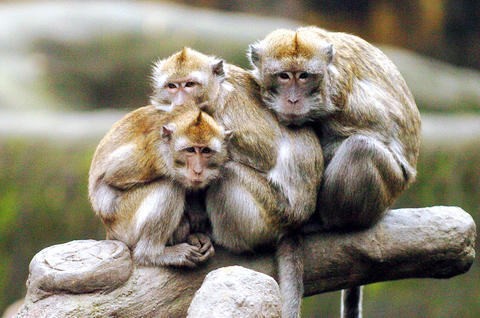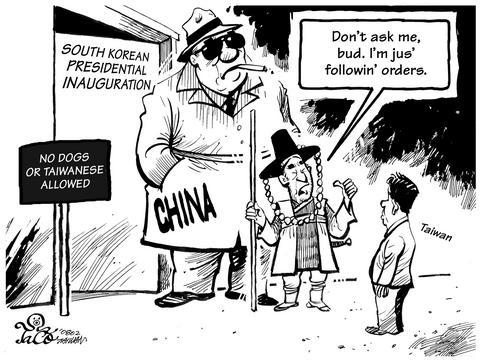 |
| TOO COLD TO
MONKEY AROUND Three macaques huddle together as protection against the cold at the Taipei Zoo yesterday. A cold front from China has caused temperatures nationwide to drop sharply.
|
Officials
implore visitors to respect stone carvings
DISAPPEARING HERITAGE:
Officials said 2,000-year-old Aboriginal stone carvings in the Central Mountain
Range were recently damaged by fire and an industrial adhesive
STAFF WRITER, WITH CNA
Thursday, Feb 28, 2008, Page 2
Officials from the Council for Cultural Affairs urged the public yesterday to
help protect 2,000-year-old stone carvings and sculptures located in the Central
Mountain Range that have been damaged recently.
Officials, who visited the site with members of the Kaohsiung County Government
last week to determine if it should be designated a national historic site,
confirmed that the stone carvings had been damaged by fire and an industrial
adhesive, which they said may have been used in the process of making stone
rubbings.
The officials believe the fires were lit to burn away a 3.3cm-thick layer of
moss covering the carvings, located in a remote area of Maolin Township (茂林) in
Kaohsiung County.
Tsao Chia-wen (曹家文), head of a preparatory committee for the council's planned
Cultural Assets Management Department, said he and his colleagues could not be
certain if the damage was caused by members of an academic organization as
reported by a media outlet a day earlier.
Tsao said that instructions and warning signs would be posted at the entrance of
the Wanshan mountain area to remind people of the archeological and cultural
value of the stone carvings and the importance of protecting them.
The series of carvings were first discovered by mountain climbers in 1972, and
are believed to be the work of the Rukai, one of the nation's 12 indigenous
groups, up to 2,000 years ago.
The 14 groups of carvings include images of human faces, geometric patterns
composed of circles and hundred-pacer snakes, a totem of the Rukai people. They
are seen as treasures of Aboriginal culture and history.
The Kaohsiung County government designated the area as a historic site in 2006,
but Tsao was unsure yesterday if the site would be upgraded to a national
historic site.
He said a committee established to consider the matter would meet again soon to
discuss the site's archeological, ethnic, artistic and architectural
significance.
A resolution on the site's status is expected to be made late next month, Tsao
said.
The council's Cultural Assets Management Department preparatory office said
organizations or individuals who are interested in viewing or taking impressions
of the Wanshan Aboriginal stone carvings should first apply with the Kaohsiung
County Government to obtain a permit.
The site can only be reached by crossing mountains and rivers on foot.
Those who damage artifacts face fines up to NT$1 million (US$33,000) or jail
terms of up to five years, the officials said.
DPP, KMT to
remember victims of 228 Incident
BLOODY CRACKDOWN: DPP
supporters will march through Taipei starting at 2
By Ko Shu-ling
STAFF REPORTER, WITH STAFF WRITER
Thursday, Feb 28, 2008, Page 3
The presidential campaign teams of the Democratic Progressive Party (DPP) and
the Chinese Nationalist Party (KMT) will today hold activities to commemorate
the thousands killed during the 228 Incident.
The 228 Incident refers to the KMT government's bloody crackdown on
demonstrators and the local elite under dictator Chiang Kai-shek's (蔣介石)
administration.
On the evening of Feb. 27, 1947, a woman named Lin Chiang-mai (林江邁), who had
been selling smuggled cigarettes in Taipei, was beaten by an agent from the
Monopoly Bureau.
Lin was left bloody and unconscious on the ground and an angry crowd gathered
and turned on the agents, who fired their guns into the crowd indiscriminately
in order to escape, killing a man named Chen Wen-hsi (陳文溪).
When monopoly agents were discovered pistol-whipping two children for a similar
offense the following day, an angry crowd beat the agents to death. Nationwide
anti-KMT protests and riots followed.
KMT troops from China were ordered in early March to quell the disturbances and
as a result tens of thousands of Taiwanese were killed.
The massacre remained taboo for decades under Chiang's rule. Chiang died in
1975.
It was not until 1995 that then KMT president Lee Teng-hui (李登輝) made the first
official apology for the incident. The legislature later agreed on compensation
and made Feb. 28 an official national holiday.
This year, the anniversary will be decidedly political as it comes during a
presidential campaign between the DPP's Frank Hsieh (謝長廷) and the KMT's Ma Ying-jeou
(馬英九).
DPP supporters will march through the streets of Taipei today, starting at
2:28pm, to mark the name of the incident. They will then hold an evening rally
at Zhongshan Soccer Stadium that is expected to draw a crowd of 10,000, the
organizers said.
DPP Deputy Secretary-General Lan Shih-tsung (藍世聰) said that the party welcomes
all party members and DPP government officials to participate based on each
individual's free time and physical condition.
Other than Hsieh and his running mate Su Tseng-chang (蘇貞昌), no other politicians
have been invited to the event, he said.
When asked whether President Chen Shui-bian (陳水扁) or Vice President Annette Lu
(呂秀蓮) would attend the rally, Hsieh, who doubles as DPP chairman, told reporters
at DPP headquarters yesterday that it was up to the organizers to decide, adding
that the organizers should have invited all party members.
The Presidential Office said yesterday that Chen would be attending an event to
be held at the Taiwan Democracy Memorial Hall.
Across town, Ma will attend a tribute concert for the victims, his office said,
adding that some 1,000 people were expected to attend.
Ahead of the anniversary yesterday, Hsieh called for the public release of
further information from the 228 Incident files and criticized Ma for
obstructing budgets proposed to fund a memorial museum and take care of the
victim's families.
Hsieh said many tragedies happened during the Martial Law era and the problems
caused by transitional justice still persist today despite the nation's change
of government.
"I would like to see more files opened and the truth of the matter divulged," he
said.
"The purpose is not to apportion blame but to discover the truth, so the
families of the victims know where their loved ones were buried and can come to
terms with their tragic loss," Hsieh said while visiting the families of victims
of the Martial Law era in Shilin (士林), Taipei.
The family of Yang Deng-hui (楊登惠), one of the victims, said that Yang was taken
away by the authorities in 1950 and never came back. They said they did not dare
inquire about him until Lee became president. They later found out from a
declassified document that Yang had been executed for treason in 1954.
While Ma has proposed the construction of a 228 memorial museum should he be
elected, Hsieh said the reality was that such a museum was already planned but
the pan blue-controlled legislature had frozen the NT$1.5 billion in funds
earmarked for it.
"It is regrettable that the KMT did not use any of its considerable assets to
help take care of the victim's families," Hsieh said.

Lessons
from 228
Thursday, Feb 28, 2008, Page 8
Two years ago this week, I was at Taipei's 228 Museum preparing my radio program
for Radio Taiwan International (formerly the Central Broadcasting System of
China). The museum building had originally housed the Taiwan Broadcasting
Company that had been set up by the Japanese, but was taken over by the Chinese
Nationalist Party (KMT) when Taiwan was "handed over" to Chiang Kai-shek's (蔣介石)
Republic of China.
As I looked at the displays, I thought: "How ironic that I am now working for
what once had been Chiang Kai-shek's Ministry of Truth," which years later was
now trying to be a voice of the people.
As I walked through the museum, the stories I had read about "the incident" came
to life through the photographs, drawings and eyewitness accounts of the scuffle
that grew into a massacre. I was haunted by the voices, now preserved in digital
audio, of those involved in the conflict:
First there were the excited, desperate voices of young Taiwanese. On the day
the massacre began, they took over radio stations to send their message of
distress to the world. They told the world of the drama unfolding on the streets
of Taipei -- and called on their countrymen around Taiwan to protest the
violence.
Then came the stern, authoritarian voices of the military rulers. In firm,
measured tones, they announced the government's response to the crisis and
warned people to stay home and behave.
As I looked and listened, I heard another voice in my head: the voice of a
friend who clearly considered herself to be more Chinese than Taiwanese.
A few days earlier, she had told me: "Taiwanese don't want democracy. They want
to be protected -- to be rich and to be protected."
At the time, all I could say was: "Protected from whom?"
The KMT's answer has always been that it was protecting Taiwan from "communist
insurgents" from "the Mainland."
Indeed, "protecting Taiwan from the communists" was, from the beginning,
Chiang's excuse for the 1947 massacre that by government estimates resulted in
between 18,000 and 28,000 people killed during the weeks and months that
followed the protests and riots on Feb. 28.
Chiang's son and heir, Chiang Ching-kuo (蔣經國), used this same rationale to
defend the KMT's decades-long reign of terror that saw the disappearance,
imprisonment, torture and execution of thousands more.
And it was the explanation I always heard from KMT supporters every time the
subject of Chiang Kai-shek came up in conversation: Chiang was protecting
Taiwan. This was always followed by the argument that: "You do not understand
Chinese affairs because you are not Chinese."
This non-explanation was the same one used by KMT chairman Ma Ying-jeou (馬英九)
when he was grilled on the BBC program Hard Talk. Not surprising, since Ma
himself was Chiang Ching-kuo's English translator.
So perhaps I shouldn't have been surprised when I read a recent news story about
Chiang Ching-kuo's son, John Chiang (蔣孝嚴), who seems pathologically addicted to
defending the honor of the father who didn't seem to want him and the
grandfather whose attitude toward him was even worse.
John Chiang has again lost his libel lawsuit against former Democratic
Progressive Party chairman Yu Shyi-kun. John Chiang had filed the lawsuit after
Yu said that Chiang Kai-shek was the "culprit" behind the 228 Incident.
The paper that published the story correctly noted that Chiang Kai-shek had
"fled to Taiwan after losing a civil war to Mao Zedong's [毛澤東] communists in
China."
But the pro-KMT paper couldn't leave it there. It had to add that Chiang
Kai-shek "is remembered by some as the man who laid the foundation for the
island's economic prosperity and safeguarded it from Chinese invasion."
Well, no doubt he is remembered that way by John Chiang, Lien Chan (連戰), James
Soong (宋楚瑜), and heir-apparent Ma.
But to anyone who bothers to learn about Taiwanese history, three things are
abundantly clear:
The first is that it was the Japanese who -- in their 50-year occupation of
Taiwan -- developed Taiwan's economy and civil society to a level unimagined in
China.
The second is that the only things Chiang Kai-shek safeguarded Taiwan from was
the prosperity delivered by the Japanese and the democracy dreamed of by Sun
Yat-sen (孫中山).
And finally, there is only one thing the people of Taiwan -- whether they call
themselves "Taiwanese" or "Chinese" or "Aboriginal" -- ever needed to be
protected from: Chiang Kai-shek and the KMT's reign of terror.
Stephen Nelson
Toronto, Canada